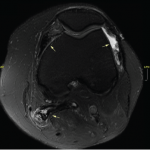It has been observed that muscle weakness correlates poorly with the inflammatory cell infiltrates detected in muscle biopsies, suggesting that non-immune cell-mediated mechanisms may play a key role in causing weakness in patients with IIM.2 What could these be?
One consideration is that the endoplasmic reticulum (ER) stress response triggered by myositis can create intramuscular havoc by altering the cellular respiration of myocytes, leading to an overproduction of reactive oxygen species. These chemicals can be noxious to the cells’ work engines, the ER and the mitochondria. Any alterations to these organelles may disrupt the proper flow of calcium or potassium ions across specialized channels that is required to generate the energy for muscle contraction to occur. Without contraction, there is no strength. Yet in some patients with myositis, this physiologic injury may persist even in the absence of active muscle inflammation creating management challenges for the treating clinician.
Another conundrum arises when patients treated with glucocorticoids develop proximal muscle weakness. Because a steroid-induced myopathy is painless, patients are rarely aware of its stealthy development until the weakness begins to disrupt their lifestyle. Is their underlying illness getting worse and in need of even higher doses of steroids, or are steroids the culprit for their loss of strength? If we don’t ask the right questions, we may fail to identify the proper cause. The lack of diagnostic blood tests or imaging studies adds to the challenge.
Steroid-induced myopathy, first described in 1932 by Harvey Cushing, MD, in patients afflicted with the disease carrying his name, is thought to be mediated via a toxic effect of corticosteroids on muscle tissue.3 However, we know little about its pathogenesis, save for the finding of type II muscle fiber atrophy left in its wake. Sadly, steroid-induced myopathy has long been neglected by researchers; it’s been well over 30 years since the publication of any novel research in this field.
Yes, weakness can be alarmingly insidious. Years ago, I assumed the care of a middle-aged woman diagnosed with lupus who was becoming progressively weaker over the course of several months. She knew that she was slowing down; her gait was impaired, and she began to stumble and frequently fall. She felt sluggish. A patron of the arts, her world shrank as she became homebound. Her rheumatologist began prescribing monthly courses of intravenous cyclophosphamide and bolus doses of steroids to supplement her daily dose of that drug in the belief that she was developing motor weakness due to an underlying peripheral neuropathy caused by her lupus. Yet, her weakness only worsened.


